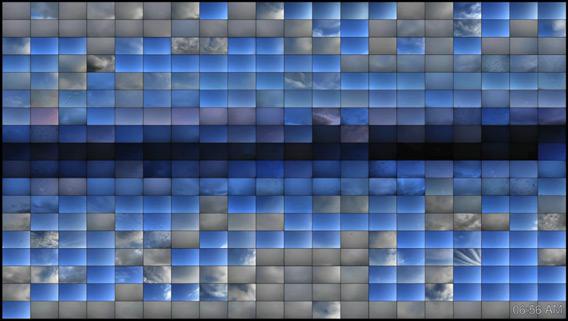We live embedded in cycles, obvious and subtle. Shorter cycles are easy to spot: The Sun rises every day, sets at night, the stars come out, the Moon moves across the sky. Others are longer and more difficult to notice: The temperatures rise and fall with the seasons, the length of the day changes during the course of the year, the peak height of the Sun above the horizon near midday increases and decreases over weeks and months.
Artist, musician, photographer and self-proclaimed “tinkerer” Ken Murphy discovered an interesting way to juxtapose these various cycles. He installed a camera on the roof of the Exploratorium hands-on museum in San Francisco and programmed it to take a picture every ten seconds for a full year, starting in July 2009.
Now, if he had simply created a single, long video, it wouldn’t help much; the short day/night cycles would still be easy to see, while the longer cycles would not. So he did something very, very clever: he split the video into 360 individual daily videos and displayed them in an array, 18 rows and 20 columns. He then synchronized them so they all show the same time of day at the same time, and let them roll. The result is this ethereal time-lapse video, “A History of the Sky”:
[It’s also up on YouTube.]
The upper left corner shows the sky on July 28, 2009, and then each successive day is in the next rectangle over. As the video progresses, you see the same time of day in each video; there’s a clock in the lower right that displays the time. Each video starts at about 4:00 a.m. and ends at 8:30 p.m.
Suddenly, the longer cycles become obvious: In the summer, the days are longer, and the Sun rises earlier and sets later.* So the boxes showing the summer sky—at the top and bottom of the main video—get bright first and dark last. Winter days are in the middle of the main video (New Year’s Day is roughly in the middle), with the Sun rising later and setting earlier.
It may take you a moment or two to grasp what you’re seeing, but it’s worth the effort. Once you get that, more subtle variations become apparent, like how the weather is grayer in the winter (it doesn’t generally get cold enough to snow in San Francisco, but it does get cloudy and more dreary during those months), but with fantastic and beautiful blue skies the majority of the year. If you pay attention to some individual days you can also see how they start off foggy, but that usually clears up by mid-morning.
You know what I’d love to see next? A video like this with each box displaying a wide-angle view from a camera facing south, toward the Sun, showing it rising and setting every day. You could then see the different paths the Sun takes, the different arcs across the sky, caused by the tilt of the Earth and its slightly elliptical orbit. That would be amazing.
Time-lapse photography allows us to see things our eyes and brains may not otherwise notice, or at least lets us see tings in a new way. It never occurred to me that a time-lapse video could become a meta-view of the sped-up sky. I love it when I get to experience something new, something clever. It’s always wonderful to get new eyes on the world around us.
Tip o’ the lens cap to APOD.
Correction, Aug. 11, 2013: This post originally stated that the sun sets earlier in the summer. It sets later. (Return.)
